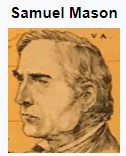In September 1777, Fort Henry in present-day West Virginia, named for Patrick Henry, was besieged by a Native American force of 200-300 led by Chief Dunquat. The fort was defended by a small militia under Captains Samuel Mason and Joseph Ogle. Despite casualties, Mason, Ogle, and their men held out until reinforcements arrived, including a dramatic group led by Major Samuel McColloch who famously escaped by riding his horse off a 300 foot cliff, in an event known as McColloch's Leap. After failing to capture Fort Henry, the Native force withdrew the next day, having suffered 10 casualties versus 23 American deaths. The battle was an important early defense of frontier settlements in the Ohio Country during the Revolutionary War. (https://tinyurl.com/3z7h3p2c) (https://tinyurl.com/yw73yc6d)
|
Today in Wheeling History: September 1--A mixed Native American force besieged Fort Henry in Wheeling, but was repelled after reinforcements arrived for the American militia defending the fort (1777).
In September 1777, Fort Henry in present-day West Virginia, named for Patrick Henry, was besieged by a Native American force of 200-300 led by Chief Dunquat. The fort was defended by a small militia under Captains Samuel Mason and Joseph Ogle. Despite casualties, Mason, Ogle, and their men held out until reinforcements arrived, including a dramatic group led by Major Samuel McColloch who famously escaped by riding his horse off a 300 foot cliff, in an event known as McColloch's Leap. After failing to capture Fort Henry, the Native force withdrew the next day, having suffered 10 casualties versus 23 American deaths. The battle was an important early defense of frontier settlements in the Ohio Country during the Revolutionary War. (https://tinyurl.com/3z7h3p2c) (https://tinyurl.com/yw73yc6d)
0 Comments
Leave a Reply. |
Mike MinderMike Minder was born and raised in Wheeling, West Virginia. He is the author of Wheeling's Gambling History to 1976. Archives
May 2024
Categories
All
|





 RSS Feed
RSS Feed
